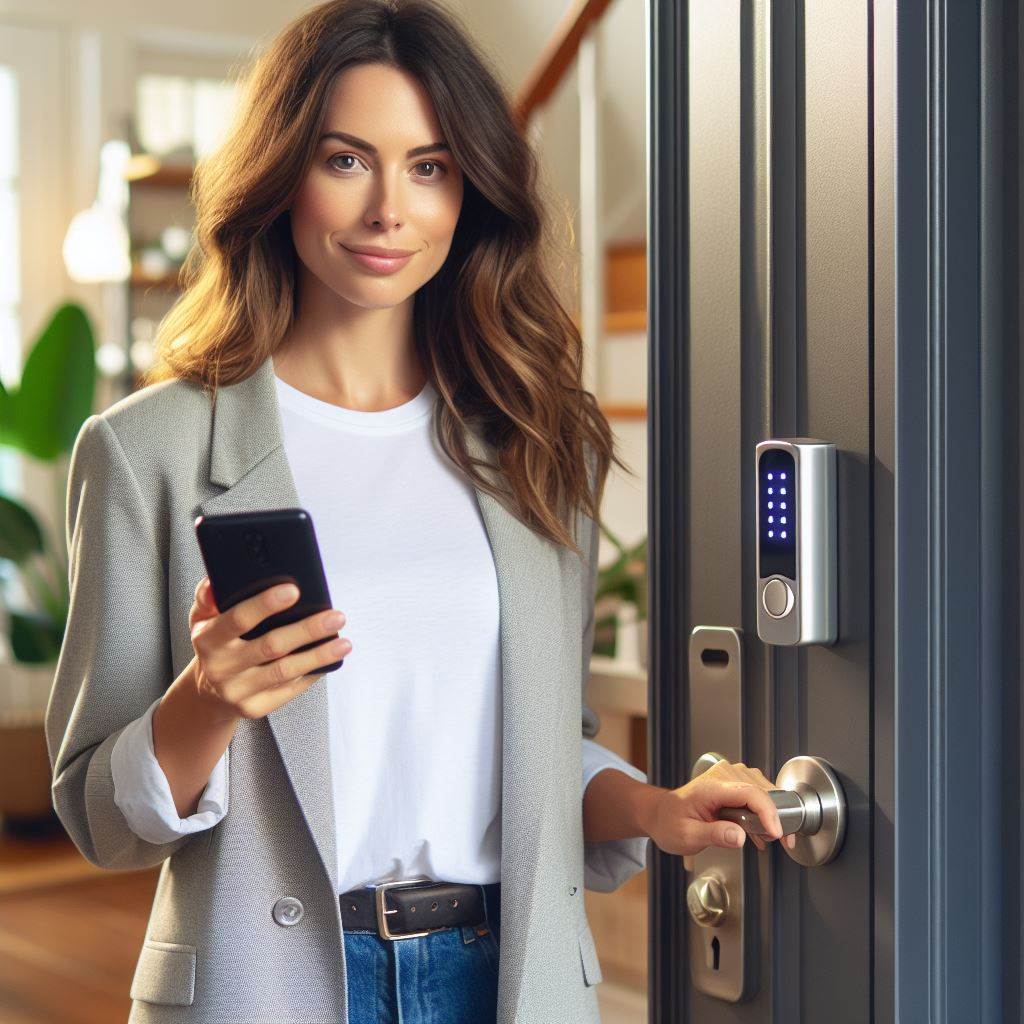Introduction
In an era where convenience and efficiency reign supreme, wireless technology has emerged as a game-changer in transforming our homes into smarter and sleeker spaces.
This blog post delves into the significance of wireless tech in revolutionizing home environments, exploring its role in enhancing convenience, efficiency, and aesthetics.
Wireless technology has become synonymous with modern living, offering unparalleled convenience and flexibility.
From smart thermostats to voice-controlled assistants, the integration of wireless devices has redefined the way we interact with our living spaces.
By eliminating the constraints of traditional wired systems, wireless tech allows for seamless connectivity and control, empowering homeowners to optimize their environment with ease.
The importance of wireless technology in making homes smarter and sleeker cannot be overstated.
Not only does it streamline everyday tasks, but it also fosters a more connected and efficient living experience.
Imagine being able to adjust the lighting, temperature, and security of your home from the palm of your hand, all through a centralized wireless system.
This level of control not only enhances convenience but also contributes to energy savings and overall comfort.
Moreover, wireless technology plays a pivotal role in enhancing the aesthetics of modern homes.
With the removal of unsightly wires and bulky devices, wireless solutions enable a cleaner and more minimalist design aesthetic.
Sleek, unobtrusive devices seamlessly blend into the background, allowing the focus to remain on the beauty of the space itself.
The Advancements in Wireless Technology
The evolution of wireless technology in recent years
In the realm of home technology, wireless advancements have revolutionized the landscape, making homes smarter and sleeker than ever before.
Over the recent years, wireless technology has undergone a remarkable evolution, ushering in an era of unparalleled convenience and connectivity for homeowners worldwide.
Overview of various wireless devices and systems used in homes
The journey of wireless technology began with the advent of Wi-Fi, which liberated homes from the constraints of wired connections.
Transform Your Real Estate Decisions
Unlock personalized real estate insights crafted just for you. Get actionable advice designed to amplify your success.
Get StartedSince then, the progression has been relentless, with each year witnessing the emergence of more sophisticated wireless devices and systems.
From smart thermostats and lighting controls to security cameras and entertainment systems, the array of wireless devices available for modern homes is staggering.
One of the most significant benefits of wireless technology is its ability to seamlessly integrate disparate systems within the home.
With the rise of smart home hubs and voice assistants, homeowners can now control various devices with a simple voice command or through a centralized app.
This level of interconnectedness not only enhances convenience but also contributes to a more streamlined and efficient living experience.
How wireless tech has improved convenience and connectivity in homes
Moreover, the advancements in wireless technology have extended beyond mere convenience to enhance home security and energy efficiency.
Wireless security cameras and sensors enable homeowners to monitor their property remotely, while smart thermostats and lighting systems optimize energy usage based on occupancy and preferences.
The proliferation of wireless technology has also facilitated the rise of the Internet of Things (IoT), wherein everyday objects are interconnected and capable of exchanging data.
This interconnected ecosystem enables homes to adapt to the needs and preferences of their occupants dynamically.
In essence, wireless technology has transformed homes into intelligent spaces that cater to the needs and preferences of their inhabitants seamlessly.
As the pace of innovation continues unabated, we can only anticipate further enhancements that will make homes even smarter, sleeker, and more responsive to the needs of modern living.
Read: AI & Real Estate: A Future of Smart Investing
Smart Home Automation
The concept of smart homes
Smart home automation is revolutionizing the way we live by integrating wireless technology into our homes.
With the ability to control various devices and systems remotely, smart homes offer convenience, efficiency, and increased security.
Showcase Your Real Estate Business
Publish your company profile on our blog for just $200. Gain instant exposure and connect with a dedicated audience of real estate professionals and enthusiasts.
Publish Your ProfileHow wireless technology enables home automation
Wireless technology forms the backbone of smart home automation, allowing devices to communicate with each other and with homeowners through a wireless network.
This eliminates the need for cumbersome wires and enables seamless connectivity and control.
The advancements in wireless technology have made it easier than ever to transform a traditional home into a smart home. Here’s how it works:
- Wireless Communication: Smart home devices use wireless protocols such as Wi-Fi, Bluetooth, Zigbee, and Z-Wave to communicate with each other and with the homeowner. This enables seamless control and monitoring of devices from anywhere within the home or even remotely.
- Hub and Control Devices: Smart home automation systems often include a central hub or control device that acts as a command center. This hub connects to various smart devices and allows the homeowner to control and automate them through a smartphone app or voice commands.
- Sensors and Actuators: Wireless sensors are an essential component of smart home automation. These sensors can detect motion, temperature, light, and other environmental conditions, sending this data to the control hub. Actuators, on the other hand, can physically control devices like smart lights, locks, and thermostats based on commands received from the control hub.
Examples of popular smart home devices and their wireless features
Smart Thermostats
Wireless thermostats like the Nest Learning Thermostat or Ecobee4 allow homeowners to control their home’s temperature remotely.
These devices learn your preferences and adjust the temperature based on occupancy, saving energy and money.
Smart Lighting Systems
Wireless lighting systems such as Philips Hue or Lutron Caseta enable homeowners to control their lights with a smartphone or voice commands.
They offer features like dimming, scheduling, and even changing the color of the light.
Smart Security Systems
Wireless security systems like SimpliSafe or Ring provide enhanced security features such as motion detection, video surveillance, and remote monitoring.
Homeowners can receive real-time alerts and monitor their homes from anywhere using their smartphones.
Smart Home Assistants
Devices like Amazon Echo or Google Home utilize wireless technology to provide voice-controlled smart home automation.
They can control various devices, answer questions, and perform tasks based on voice commands.
Smart Appliances
Wireless connectivity is increasingly being integrated into appliances like refrigerators, ovens, and washing machines.
These devices can be controlled and monitored remotely, offering convenience and energy efficiency.
Smart Entertainment Systems
Wireless speakers, TVs, and streaming devices like Sonos, Roku, or Chromecast allow homeowners to create a connected and immersive entertainment experience.
Users can stream music, movies, or TV shows wirelessly from their smartphones or other devices.
Smart Home Security Cameras
Wireless security cameras like Arlo or Blink offer easy installation and flexibility in terms of placement.
Homeowners can monitor their homes 24/7, receive motion alerts, and even communicate with visitors remotely.
In fact, wireless technology has paved the way for a smarter and sleeker home automation experience.
The concept of smart homes is no longer a distant future but a reality that offers convenience, efficiency, and increased security.
By harnessing the power of wireless technology, homeowners can transform their traditional homes into a connected and intelligent living environment.
Read: Home Automation: The Future of Real Estate?
Wireless Security Systems
Wireless security systems have revolutionized the way we protect our homes, offering convenience and peace of mind.
Through the use of wireless technology, these systems have become smarter, sleeker, and more effective in ensuring the safety of our homes.
Overview of Wireless Security Systems and Their Benefits
Wireless security systems are composed of various devices that work together to create a comprehensive security network.
These systems utilize wireless communication to connect the different components, eliminating the need for complicated wiring installations.
The primary benefit of wireless security systems is the flexibility they offer. It is easy to add or remove devices as needed.
Wireless technology allows for remote access to the security system, enabling homeowners to monitor their properties from anywhere at any time through smartphone apps or web portals.
In case of a power outage or internet disruption, wireless security systems continue to function thanks to backup batteries and cellular communication options.
Advantages of Wireless Security Cameras, Motion Sensors, and Alarms
Wireless security cameras provide a clear advantage over their wired counterparts as they can be installed virtually anywhere within a property.
These cameras transmit high-definition video feeds wirelessly, allowing homeowners to monitor their homes with ease.
Showcase Your Real Estate Business
Publish your company profile on our blog for just $200. Gain instant exposure and connect with a dedicated audience of real estate professionals and enthusiasts.
Publish Your ProfileWireless motion sensors are another crucial component of security systems, as they detect any unauthorized movement within a protected area.
These sensors wirelessly transmit signals to the central control panel, triggering alarms and notifying homeowners or monitoring services of potential intrusions.
Wireless alarms are an essential part of any security system, alerting homeowners and deterring potential burglars with loud sirens or silent alerts sent to mobile devices.
The advantage of wireless alarms is the ease of installation, as they do not require invasive wiring and can be placed discreetly throughout the home.
Importance of Wireless Technology in Ensuring Home Safety
Wireless technology plays a vital role in ensuring the safety of homes by enabling seamless communication between security devices.
It eliminates vulnerabilities associated with wired systems, such as the possibility of intruders cutting physical wires to disable the security system.
Wireless technology also provides homeowners with timely notifications and updates regarding any security breaches or system malfunctions.
The ability to remotely access and control security systems through wireless connectivity ensures constant surveillance and quick response times in case of emergencies.
Additionally, wireless security systems integrate with other smart home devices, allowing homeowners to create a comprehensive and interconnected ecosystem of safety and convenience.
With the advancements in wireless technology, security systems have become smarter, allowing for features like facial recognition, predictive analytics, and voice control.
In essence, wireless security systems have revolutionized home protection by offering flexibility, convenience, and enhanced functionality.
The use of wireless technology in security cameras, motion sensors, and alarms has made homes smarter and safer than ever before.
With constant advancements, wireless security systems continue to evolve and play a vital role in ensuring the peace of mind of homeowners.
Read: Revolutionizing Price Predictions with ML Tech

Entertainment and Connectivity
How wireless technology has revolutionized home entertainment
Wireless technology has revolutionized home entertainment, offering convenience and enhancing the overall experience.
One of the key advancements in wireless entertainment is the ability to stream audio and video content seamlessly.
Wireless audio and video streaming devices
Wireless audio streaming devices, such as Bluetooth speakers, have become popular due to their portability and ease of use.
These devices allow users to connect their smartphones or tablets wirelessly and enjoy music in any room of the house.
Wireless video streaming devices, such as smart TVs and streaming sticks, have also gained popularity.
These devices allow users to access a wide range of online streaming services, such as Netflix and YouTube, directly on their TVs.
This eliminates the need for cable or satellite subscriptions and provides a more personalized entertainment experience.
Wireless connectivity has also benefited multiple devices in a home, creating a seamless and interconnected environment.
For example, smart homes are equipped with wireless hubs that connect various devices, such as lights, thermostats, and security systems.
These devices can be controlled remotely using a smartphone or voice commands, making it more convenient and efficient.
Benefits of wireless connectivity for multiple devices in a home
Wireless connectivity also allows for easy integration with other smart devices, such as virtual assistants like Amazon Echo or Google Home.
Users can simply speak commands to control their entertainment systems or access various online services.
Additionally, wireless connectivity enables multi-room audio systems, where users can play music in different rooms simultaneously.
This is achieved by connecting multiple wireless speakers to a central hub, which allows for synchronized playback across the house.
Moreover, wireless technology has made it possible to eliminate the clutter of cables and wires that often come with traditional entertainment setups.
With wireless speakers and streaming devices, users no longer need to worry about hiding or managing cables.
Showcase Your Real Estate Business
Publish your company profile on our blog for just $200. Gain instant exposure and connect with a dedicated audience of real estate professionals and enthusiasts.
Publish Your ProfileThis not only provides a sleeker and cleaner look but also makes it easier to rearrange furniture or set up a new entertainment system.
Furthermore, wireless technology has brought about advancements in the quality and reliability of home entertainment.
Wireless audio streaming devices now support high-definition audio codecs, such as aptX and AAC, for superior sound quality.
Similarly, wireless video streaming devices support high-resolution formats, such as 4K and HDR, for a more immersive viewing experience.
In a nutshell, wireless technology has transformed home entertainment by offering convenience, connectivity, and improved audiovisual experiences.
Wireless audio and video streaming devices have become increasingly popular, providing seamless access to a wide range of content.
Additionally, wireless connectivity enables the integration and control of multiple devices in a smart home environment.
This technology not only enhances the overall entertainment experience but also contributes to a sleeker and more efficient home setup.
Read: Smart Security Systems: Safer Homes, Higher Value
Energy Efficiency and Home Management
Wireless technology has revolutionized the way we manage energy in our homes, making them more efficient and convenient.
By utilizing smart home devices that monitor and control energy usage, homeowners can reduce their environmental impact and save money on utility bills.
Overview of how wireless tech contributes to energy-efficient homes
- Remote monitoring and control: Wireless technology enables homeowners to monitor and control energy usage even when they are away from home. This allows for efficient management of appliances and systems, reducing unnecessary energy consumption.
- Real-time data analysis: Smart home devices collect data on energy usage, providing real-time analysis and insights. Homeowners can identify areas of high consumption and make adjustments to optimize energy efficiency.
- Energy-saving algorithms: Wireless tech incorporates intelligent algorithms that learn from homeowners’ behavior and adjust energy usage accordingly. This helps in reducing energy waste and achieving maximum efficiency.
Examples of smart home devices that monitor and control energy usage
- Smart thermostats: These devices learn the household’s temperature preferences and adjust HVAC systems accordingly. They can be controlled remotely, optimizing energy usage and reducing heating and cooling costs.
- Smart lighting systems: Wireless-enabled light bulbs and switches allow for dimming, scheduling, and remote control. This ensures that lights are only used when needed, reducing unnecessary energy wastage.
- Energy monitoring plugs: These plugs can be inserted into any electrical outlet to track energy consumption of connected devices. Homeowners can identify energy-hungry appliances and take appropriate measures to reduce usage.
How wireless technology aids in managing home appliances and systems
- Home automation: Wireless technology enables the automation of various home appliances and systems. For example, homeowners can set schedules for dishwasher and laundry machines to run during off-peak hours, reducing energy demand.
- Integration with renewable energy sources: Wireless tech allows for seamless integration of renewable energy sources like solar panels and wind turbines. Homeowners can monitor energy generation and consumption to maximize their renewable energy utilization.
- Energy management platforms: Wireless technology provides centralized energy management platforms that allow homeowners to monitor and control multiple devices and systems from a single interface. This simplifies energy management and increases overall efficiency.
- Demand-response systems: Wireless tech facilitates demand-response programs where energy providers can communicate with smart devices to temporarily reduce energy consumption during peak periods. This helps in balancing the energy grid and avoids overloading.
All in all, wireless technology plays a crucial role in making our homes smarter and more energy-efficient.
By utilizing smart home devices, homeowners can monitor and control energy usage, optimize appliance and system management, and ultimately save on energy bills while reducing their environmental footprint.
Challenges and Considerations
As we step into the era of smart homes propelled by wireless technology, we encounter both opportunities and challenges.
While the allure of a seamlessly connected and sleek living space is undeniable, it’s essential to address the hurdles that come with it.
Connectivity Issues and Solutions
One of the foremost challenges in wireless home technology is connectivity reliability.
Dead spots and interference can disrupt signals, leading to frustration.
To combat this, strategic router placement and the use of range extenders or mesh networks can help blanket the home with consistent coverage.
Additionally, opting for dual-band or tri-band routers can alleviate congestion on the network, ensuring smoother communication between devices.
Data Security and Privacy
With the influx of interconnected devices, data security and privacy become paramount concerns.
Each smart gadget acts as a potential entry point for hackers if not adequately secured.
Implementing robust encryption protocols, regularly updating firmware, and segmenting the network can fortify defenses against cyber threats.
Furthermore, opting for devices with built-in security features and scrutinizing privacy policies before purchase can safeguard sensitive information from unauthorized access.
Optimizing Wireless Connectivity
To maximize wireless connectivity in homes, several tips can prove invaluable.
Firstly, eliminating sources of interference such as microwaves and cordless phones can enhance signal strength.
Moreover, updating devices and router firmware ensures compatibility with the latest standards, optimizing performance.
Utilizing Quality of Service (QoS) settings on routers prioritizes bandwidth for essential tasks, preventing lag during high-demand activities like streaming or gaming.
Lastly, regular network audits can identify and address bottlenecks, fine-tuning the system for peak efficiency.
Therefore, while wireless technology offers a glimpse into the future of smart and sleek homes, overcoming challenges is imperative to harness its full potential.
By addressing connectivity issues, prioritizing data security, and implementing optimization techniques, homeowners can create an ecosystem where convenience seamlessly intertwines with reliability and privacy.
Showcase Your Real Estate Business
Publish your company profile on our blog for just $200. Gain instant exposure and connect with a dedicated audience of real estate professionals and enthusiasts.
Publish Your ProfileThe Future of Wireless Home Technology
In the ever-evolving landscape of technology, wireless innovations have become the cornerstone of modern homes, revolutionizing the way we live, work, and interact with our surroundings.
As we gaze into the future, the trajectory of wireless home technology seems boundless, promising even sleeker and smarter living environments.
Upcoming Trends and Advancements
The future of wireless home technology holds a plethora of exciting possibilities.
From augmented reality integrated seamlessly into our daily lives to ultra-fast and reliable wireless networks powering every corner of our homes, the potential for innovation knows no bounds.
Expect to see advancements in home automation, with AI-driven systems adapting to our preferences and habits in real-time, creating truly personalized living spaces.
Speculation on How Wireless Technology Will Continue to Shape Homes
Imagine a home where every device communicates effortlessly with each other, where energy efficiency is maximized through smart sensors and intelligent algorithms, and where security is enhanced through advanced biometric authentication.
The future promises homes that are not only smarter but also more intuitive and responsive to our needs.
With the advent of 5G technology, the proliferation of Internet of Things (IoT) devices will skyrocket, further blurring the lines between the physical and digital realms.
Importance of Staying Informed and Adapting to Changes
As we venture into this brave new world of wireless home technology, it’s crucial to stay informed and adaptable.
Embracing these advancements can lead to increased convenience, efficiency, and even cost savings in the long run.
However, it’s also essential to remain vigilant about potential cybersecurity threats and privacy concerns that may arise with the widespread adoption of connected devices.
Essentially, the future of wireless home technology is poised to redefine the very fabric of our living spaces.
By embracing upcoming trends and advancements, we can create homes that are not only smarter and sleeker but also more sustainable and secure.
It’s an exciting journey ahead, and by staying informed and adaptable, we can ensure that our homes remain at the forefront of innovation.
Conclusion
We have discussed the key points about wireless technology in making homes smarter and sleeker.
Integrating wireless technology in modern homes is of utmost importance as it offers convenience, safety, and efficiency.
By adopting wireless home tech solutions, homeowners can enjoy benefits like remote control of devices, energy efficiency, enhanced security, and streamlined communication.
It is evident that wireless technology has revolutionized the way we live and interact with our homes.
With a wide range of smart devices available, homeowners have the opportunity to transform their homes into smart and efficient living spaces.
By embracing wireless technology, individuals can create a home environment that is tailored to their needs and preferences.
We encourage our readers to explore the diverse range of wireless tech solutions available in the market.
Whether it is a smart thermostat, security cameras, smart appliances, or voice-controlled devices, there are endless possibilities to make your home smarter and more convenient.
The integration of wireless technology will not only add value to your home but also enhance your lifestyle.
In the end, it is clear that wireless technology is shaping the future of homes, making them smarter and sleeker.
So, why wait? Embrace wireless home tech solutions and experience the many benefits they offer.
Upgrade your home and join the growing community of tech-savvy homeowners who have transformed their living spaces into smart and connected environments.
[E-Book for Sale]
750 Lucrative Business Ideas: Your Ultimate Guide to Thriving in the U.S. Market
$49 • 750 Business Ideas • 109 pages
Unlock 750 profitable business ideas to transform your future. Discover the ultimate guide for aspiring entrepreneurs today!




